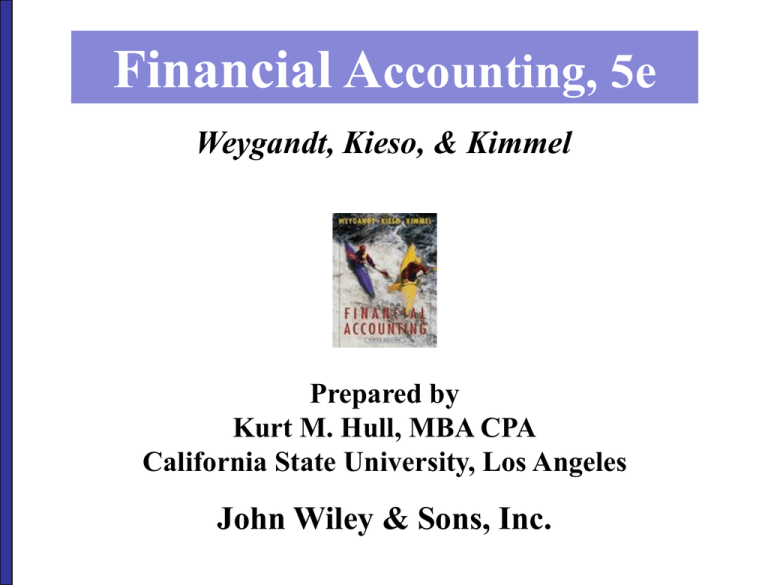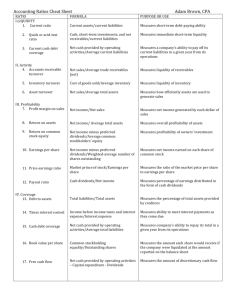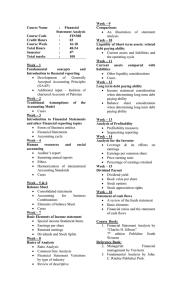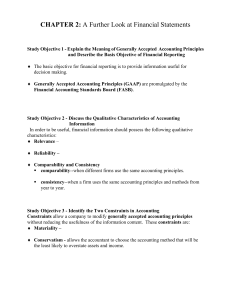
Financial Accounting, 5e
Weygandt, Kieso, & Kimmel
Prepared by
Kurt M. Hull, MBA CPA
California State University, Los Angeles
John Wiley & Sons, Inc.
CHAPTER 15
FINANCIAL STATEMENT ANALYSIS
STUDY OBJECTIVES
After studying this chapter, you should understand:
Comparative analysis
Tools used in financial statement analysis
Horizontal analysis
Vertical analysis
Liquidity, profitability, & solvency ratios
Earnings power
Limitations of financial statement analysis
STUDY OBJECTIVE 1
COMPARATIVE ANALYSIS
STUDY OBJECTIVE 2
ANALYSIS TOOLS
HORIZONTAL (TREND) ANALYSIS
evaluates a series of financial statement
data over a period of time.
VERTICAL ANALYSIS
expresses each item
in a financial statement
as a percent of a base amount
RATIO ANALYSIS
expresses the relationship among
selected items of financial statement data.
STUDY OBJECTIVE 3
HORIZONTAL ANALYSIS
Changes are measured
against a base year with
the following formula.
Change
since base
period
Current year amount — Base year amount
———————————————————————
Base year amount
HORIZONTAL ANALYSIS
OF BALANCE SHEET
HORIZONTAL ANALYSIS
OF INCOME STATEMENT
HORIZONTAL ANALYSIS
OF RETAINED EARNINGS STATEMENT
The change in January 1 retained earnings is calculated as follows
39.4%
=
525,000-376,500
376,500
QUALITY DEPARTMENT STORE INC.
Retained Earnings Statement
ILLUSTRATION 15-7
For the Years Ended December 31
Retained earnings, January 1
Add: Net income
Deduct: Dividends
Retained earnings, December 31
2003
2002
$ 525,000 $ 376,500
263,800
208,500
788,800
585,000
61,200
60,000
$ 727,600 $ 525,000
Increase or (Decrease)
during 1999
Amount Percentage
$ 148,500
39.4%
55,300
26.5%
203,800
1,200
2.0%
$ 202,600
38.6%
STUDY OBJECTIVE 4
VERTICAL ANALYSIS
Financial statement elements are
measured as a percent of the total.
Balance Sheet
Income Statement
Elements are a
percent of total assets
Elements are a
percent of total sales
VERTICAL ANALYSIS
OF BALANCE SHEET
QUALITY DEPARTMENT STORE INC.
Condensed Balance Sheets
December 31
2003
Amount
Percent
2002
Amount
Percent
Assets
Current assets
Plant assets (net)
Intangible assets
Total assets
$ 1,020,000
800,000
15,000
$ 1,835,000
55.6% $ 945,000
43.6%
632,500
0.8%
17,500
100.0% $ 1,595,000
59.2%
39.7%
1.1%
100.0%
Liabilities
Current liabilities
Long-term liabilities
Total liabilities
Stockholders’ Equity
Common stock, $1 par
Retained earnings
Total stockholders’ equity
Total liabilities and stockholders’ equity
$
344,500
487,500
832,000
275,400
727,600
1,003,000
$ 1,835,000
18.8% $
26.5%
45.3%
15.0%
39.7%
54.7%
100.0%
303,000
497,000
800,000
19.0%
31.2%
50.2%
270,000
525,000
795,000
$1,595,000
16.9%
32.9%
49.8%
100.0%
VERTICAL ANALYSIS
OF BALANCE SHEET
QUALITY DEPARTMENT STORE INC.
Condensed Income Statements
For the Years Ended December 31
Sales
Sales returns and allowances
Net sales
Cost of goods sold
Gross profit
Selling expenses
Administrative expenses
Total operating expenses
Income from operations
Other revenues and gains
Interest and dividends
Other expenses and losses
Interest expense
Income before income taxes
Income tax expense
Net income
2003
2002
Amount
Percent
Amount
Percent
$ 2,195,000 104.7% $ 1,960,000 106.7%
98,000
4.7%
123,000
6.7%
2,097,000 100.0%
1,837,000 100.0%
1,281,000
61.1%
1,140,000
62.1%
816,000
38.9%
697,000
37.9%
253,000
12.0%
211,500
11.5%
104,000
5.0%
108,500
5.9%
357,000
17.0%
320,000
17.4%
459,000
21.9%
377,000
20.5%
9,000
36,000
432,000
168,200
$ 263,800
0.4%
11,000
0.6%
1.7%
40,500
20.6%
347,500
8.0%
139,000
12.6% $ 208,500
2.2%
18.9%
7.5%
11.4%
INTERCOMPANY COMPARISION
OF INCOME STATEMENT
REVIEW QUESTION
Sammy Corporation reported net sales of
$300,000 and $330,000 for 2004 and 2005.
Calculate the percentage increase.
10%
=
330,000 - 300,000
300,000
Another way to express this change:
2005 sales are 110% of 2004 sales
STUDY OBJECTIVE 5
RATIO ANALYSIS
CURRENT RATIO
A LIQUIDITY RATIO
Evaluates liquidity
and short-term
debt-paying ability.
CURRENT ASSETS
CURRENT RATIO = ———————————
CURRENT LIABILITIES
Quality Department Store
2003
$1,020,000
————— = 2.96:1
$344,500
Industry average
————————
1.28:1
2002
$945,000
———— = 3.12:1
$303,000
Sears, Roebuck and Co.
————————————
1.32:1
ACID-TEST/QUICK RATIO
A LIQUIDITY RATIO
Measures short-term liquidity.
CASH + MARKETABLE SECURITIES + RECEIVABLES (NET)
ACID-TEST RATIO = ————————————————————————————
CURRENT LIABILITIES
Quality Department Store
Balance Sheet (partial)
2002
Current assets
Cash
Marketable securities
Receivables (net)
Inventory
Prepaid expenses
Total current assets
$
100,000
20,000
230,000
620,000
50,000
$ 1,020,000
2001
$ 155,000
70,000
180,000
500,000
40,000
$ 945,000
ACID-TEST/QUICK RATIO
Quality Department Store
2003
2002
$100,000 + $20,000 + $230,000
$155,000 + $70,000 + $180,000
—————————————— = 1.02:1 —————————————— = 1.3:1
$344,500
$303,000
Industry average
————————
0.33:1
Sears, Roebuck and Co.
————————————
0.85:1
RECEIVABLES TURNOVER
A LIQUIDITY RATIO
• Measures the liquidity of receivables.
• Measures the number of times, on average,
receivables are collected during the period.
NET CREDIT SALES
RECEIVABLES TURNOVER = ———————————————
AVERAGE NET RECEIVABLES
RECEIVABLES TURNOVER
Quality Department Store
2003
2002
$2,097,000
—————————— = 10.2 times
$180,000 + $230,000
——————————
2
[
]
Industry average
————————
10.8 times
[
$1,837,000
—————————— = 9.7 times
$200,000 + $180,000
——————————
2
]
Sears, Roebuck and Co.
————————————
2.4 times
INVENTORY TURNOVER
A LIQUIDITY RATIO
• Measures the number of times, on average,
the inventory is sold during the period .
• Measures the liquidity of the inventory.
COST OF GOODS SOLD
INVENTORY TURNOVER = ————————————
AVERAGE INVENTORY
INVENTORY TURNOVER
Quality Department Store
2003
2002
$1,281,000
—————————— = 2.3 times
$500,000 + $620,000
[
——————————
2
]
Industry average
————————
6.7 times
$1,140,000
—————————— = 2.4 times
$450,000 + $500,000
[
——————————
2
]
Sears, Roebuck and Co.
————————————
5.0 times
PROFIT MARGIN
A PROFITABILITY RATIO
• Measures the percentage of each dollar of
sales that results in net income.
• Measures how profitable the company is
NET INCOME
PROFIT MARGIN ON SALES = ——————
NET SALES
PROFIT MARGIN
Quality Department Store
2003
$263,800
—————
2002
$208,500
= 12.6%
$2,097,000
Industry average
————————
3.57%
————— = 11.4%
$1,837,000
Sears, Roebuck and Co.
————————————
8.26%
ASSET TURNOVER
A PROFITABILITY RATIO
Measures how efficiently
a company uses its assets
to generate sales.
NET SALES
ASSET TURNOVER = —————————
AVERAGE ASSETS
ASSET TURNOVER
Quality Department Store
2003
[
2002
$2,097,000
——————————— = 1.22 times
$1,595,000 + $1,835,000
———————————
2
]
Industry average
2.37 times
[
$1,837,000
——————————— = 1.21 times
$1,446,000 + $1,595,000
———————————
2
Sears, Roebuck and Co.
1.05 times
]
RETURN ON ASSETS
A PROFITABILITY RATIO
An overall measure
of profitability.
NET INCOME
RETURN ON ASSETS = —————————
AVERAGE ASSETS
RETURN ON ASSETS
Quality Department Store
2003
$263,800
———————————
$1,595,000 + $1,835,000
———————————
2
[
Industry average
————————
8.29%
2002
]
= 15.4%
$208,500
——————————— = 13.7%
$1,446,000 + $1,595,000
———————————
2
[
Sears, Roebuck and Co.
————————————
8.7%
]
RETURN ON COMMON EQUITY
A PROFITABILITY RATIO
Measures profitability
from the viewpoint of the
common stockholder.
RETURN ON COMMON
NET INCOME
STOCKHOLDERS’ EQUITY = ———————————————————————
AVERAGE COMMON STOCKHOLDERS’ EQUITY
RETURN ON COMMON EQUITY
Quality Department Store
2003
2002
$263,800
$208,500
———————————
[
= 29.3%
$795,000 + $1,003,000
———————————
2
Industry average
————————
20.5%
]
———————————
[
= 28.5%
$667,000 + $795,000
———————————
2
]
Sears, Roebuck and Co.
————————————
51.65%
EARNINGS PER SHARE
A PROFITABILITY RATIO
EPS measures
net income earned
on each share
of common stock.
EARNINGS
NET INCOME
PER SHARE = ————————————————————————————
WEIGHTED AVERAGE COMMON SHARES OUTSTANDING
EARNINGS PER SHARE
Quality Department Store
2003
2002
$263,000
————————— = $.97
270,000 + 275,400
—————————
2
[
]
$208,500
————— = $.77
270,000
PRICE TO EARNINGS
A PROFITABILITY RATIO
Measures the ratio of the market price
of each share of common stock
to the earnings per share.
MARKET PRICE PER SHARE OF COMMON STOCK
PRICE-EARNINGS RATIO = —————————————————————————
EARNINGS PER SHARE
PRICE TO EARNINGS
Quality Department Store
2003
$12.00
——— =
$ .97
12.4 times
2002
$ 8.00
——— =
$ .77
10.4 times
Industry average
Sears, Roebuck and Co.
26 times
3.8 times
————————
———————————
PAYOUT RATIO
A PROFITABILITY RATIO
Measures the percentage of earnings
distributed in the form of
cash dividends.
CASH DIVIDENDS
PAYOUT RATIO = —————————————————————————
NET INCOME
PAYOUT RATIO
A PROFITABILITY RATIO
Quality Department Store
2003
$61,200
—————
$263,800
= 23.2%
Industry average
————————
16.0%
2002
$60,000
—————
$208,500
= 28.8%
Sears, Roebuck and Co.
———————————
9.6%
TIMES INTEREST EARNED
A SOLVENCY RATIO
Measures ability
to meet interest
payments as they
come due.
Income before Income Taxes and Interest Expense
Interest Expense
Quality Department Store
2003
$468,000
———— = 13 times
$36,000
Industry average
————————
11.98 times
2002
$388,000
———— = 9.6 times
$40,500
Sears, Roebuck and Co.
————————————
6.3 times
DEBT TO TOTAL ASSETS
A SOLVENCY RATIO
Measures % of
total assets
provided by creditors
Total Debt
Total Assets
Quality Department Store
2003
$832,000 = 45.30%
$1,835,000
Industry average
————————
40.1%
2002
$800,000 = 50.20%
$1,595,000
Sears, Roebuck and Co.
————————————
76.9%
REVIEW QUESTION
Ace Ventura Pet Detective, Inc. reported the following:
Cash
Marketable Securities
Accounts Receivable
Inventory
Prepaid Insurance
Prepaid Rent
Total Assets
Current Liabilities
$125,000
$342,500
$780,000
$56,000
$3,600
$4,900
$1,729,000
$562,000
Calculate the Quick Ratio.
2.22 = (125000+342500+780000) / 562000
STUDY OBJECTIVE 6
EARNINGS POWER & IRREGULAR ITEMS
Earnings power is the
NORMAL LEVEL OF INCOME
to be obtained in the future.
Earnings power is affected by irregular items.
Three types of “Irregular” items:
1) Discontinued operations
2) Extraordinary items
3) Changes in accounting principle
DISCONTINUED OPERATIONS
• The disposal of a significant segment of a
business.
– The income or (loss) form discontinued
operations consists of two parts:
• The income or (loss) form operations and
• The gain/loss on the disposal of the segment
• The results are shown “net of tax”
DISCONTINUED OPERATIONS
STATEMENT PRESENTATION
For the year ended December 31, 2006
EXTRAORDINARY ITEMS
• Extraordinary items are events and
transactions that meet two conditions.
– unusual in nature and
– infrequent in occurrence
– the results are shown “net of tax”
EXTRAORDINARY ITEMS
STATEMENT PRESENTATION
For the year ended December 31, 2006
ORDINARY VS. EXTRAORDINARY
CHANGE IN
ACCOUNTING PRINCIPLE
• Occurs when the principle used in the current
year is different form the one used last year.
When this happens:
– The new principle is used to report the
results of operations for current year
– The cumulative effect of the change on all
prior year income statements should be
disclosed “net of tax”
CHANGE IN PRINCIPLE
STATEMENT PRESENTATION
For the year ended December 31, 2006
STUDY OBJECTIVE 7
LIMITATIONS OF F/S ANALYSIS
Estimates
Depreciation, allowances, contingencies
Cost
Historical data not adjusted for
inflation/deflation
Alternative
methods
FIFO, LIFO, Average Cost.
Completed contract, percentage of completion
Seasonal accounting data may not be
representative
Atypical data
Firm
Conglomerates hard to identify with single
diversification industry.
COPYRIGHT
Copyright © 2006 John Wiley & Sons, Inc. All rights reserved. Reproduction or
translation of this work beyond that permitted in Section 117 of the 1976
United States Copyright Act without the express written consent of the
copyright owner is unlawful. Request for further information should be
addressed to the Permissions Department, John Wiley & Sons, Inc. The
purchaser may make back-up copies for his/her own use only and not for
distribution or resale. The Publisher assumes no responsibility for errors,
omissions, or damages, caused by the use of these programs or from the use
of the information contained herein.





